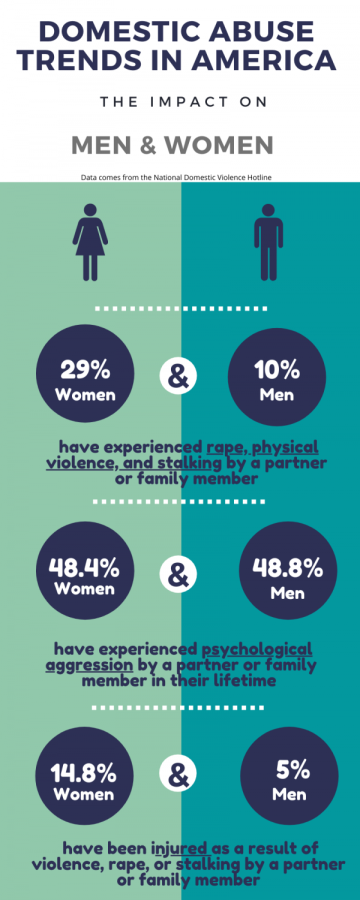Shelter-in-place leads to rise in domestic abuse cases
May 29, 2020
As countless Americans continue to shelter in place for extended periods of time amid the coronavirus pandemic, the restrictions aimed at keeping them safe have enabled more households to become grounds for domestic abuse.
Domestic violence tends to increase whenever families spend extended amounts of time together, whether it be during vacations or disasters. Now, with families on lockdown worldwide, conflicts between family members have escalated, leading to an increase in the number of domestic violence cases. Being confined to the home has also made it more difficult for individuals to separate themselves from their abusers, making it easier for the abuse to continue. However, physical violence is not always the tool of choice among abusers. Isolation from family and friends, constant surveillance and strict rules of conduct are commonly employed to control a victim’s behavior, giving more power to the abuser during the current shelter-in-place.
“Part of it is just awareness of what domestic violence is and looks like, or even just what an abusive relationship looks like,” said Emily Perez, a therapist with Teen Therapy Center of Silicon Valley. “I definitely have had the experience where I’ve been talking to people and they’re like ‘Oh wow, I see that relationship was really abusive and I didn’t notice it. They don’t know that isolating your partner from other people is abusive. They’re not getting hit physically, but that’s [still] abusive.”
The trend of domestic violence increasing during a crisis extends beyond the coronavirus pandemic. In past crises including the economic downturn of 2008, 9/11, Hurricane Sandy and Hurricane Katrina, the number of domestic abuse cases soared as conflicts became more frequent when families were confined together for extended periods of time. In the wake of the pandemic, there has been increasing concern that domestic violence will continue to grow with job losses and other economic pressures.
“One thing that is exacerbated is that people feel they literally have nowhere else to go,” Lynbrook school psychologist Dr. Brittany Stevens said. “Because of shelter in place, and our generalized fear about going out in the community and being in new environments and around new people or even touching a doorknob, people feel more trapped. I think even the average person who’s not in a highly conflictual relationship feels trapped.”
What is more alarming is that there are more cases of domestic abuse than those that have been reported. While official figures have shown that overall crimes like murder and assault are down by 25 percent in big cities, they do not reflect the violence committed in the privacy of people’s homes. In fact, nearly half of all domestic abuse cases go unreported, mainly due to victims’ fear of the impact that reaching out to authorities will have on their families. In addition, for many individuals, tolerating abuse is considered a safer option than to move to a shelter where they might be exposed to the coronavirus. Because many individuals choose not to report the abuse or do not end up following through with filing a complaint, domestic violence is notoriously difficult to track using police data. Thus, although public statistics may give a glimpse into the prevalence of domestic abuse, it grossly undercounts the number of victims.
“I think that in all domestic violence circumstances people feel a lot of guilt and shame,” Stevens said. “There can be some beliefs that the person didn’t mean to or that somehow it’s the victim’s fault and that the abuse was somehow deserved. There can be some really big cognitive distortions that happen in abusive relationships where people can begin to believe that it’s acceptable or it’s their fault.”
Another challenge victims may face is that support networks, organizations built to help them get out of a dangerous situation or to provide emotional support for abuse victims, have become less available during the lockdown, making it difficult for them to get help when they are in danger. Without a method to get out of their current situation or even to relieve any emotional or physical stress due to isolation, victims are left with very limited modes of defense. Many institutions that victims may have relied on to protect victims of domestic abuse are already underfunded and unable to respond to the increased demand for their services.
Support networks are not the only organizations shut down during the pandemic. As public offices are suspended, divorce proceedings have also been postponed until after the outbreak dies down. Due to this, spouses nationwide whose relationships have been strained are forced to live together, and the resulting tension can easily lead to violence.
In these turbulent times, it is important to stay informed about what options are available should one find themselves or loved ones in dangerous situations. Hotlines and school administrators are options that are ready to offer their support. With the surge in domestic abuse cases all across the nation caused by the quarantine, it is more important than ever to protect loved ones in order to ensure our safety during the outbreak.
“[While trying to protect yourself] the lowest level would be harm reduction, having a plan for yourself about if my partner does this, what do I need to do to keep myself safe,” Perez said. “I’m going to make sure I have phone numbers available, people I can call as emergency services, maybe have something prepared if you feel super unsafe and you feel like you need to get out, [or] contact a friend or family member who you do think you’ll feel safe with.
If students find themselves in danger of domestic abuse, they should reach out for help immediately from authorities or call the National Domestic Violence Hotline (1-800-799-SAFE(7233)), which is available at all times and in 200 different languages. If a student suspects that a friend is in danger of domestic abuse or is suffering from domestic abuse, they can offer their support by making sure they know they’re not alone and are able to seek help if they need it. If it becomes necessary, they may also need to call protection services themself in place of their friend. Other resources include Dr. Brittany Stevens, the school psychologist, and the Teen Therapy Center of Silicon Valley.





























































